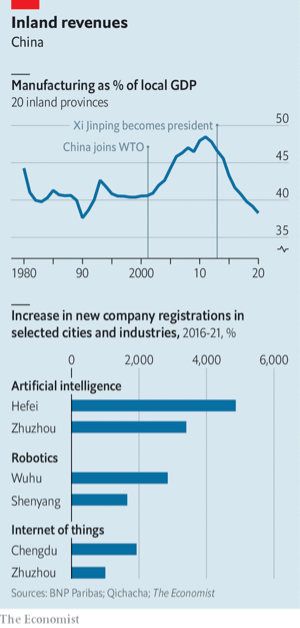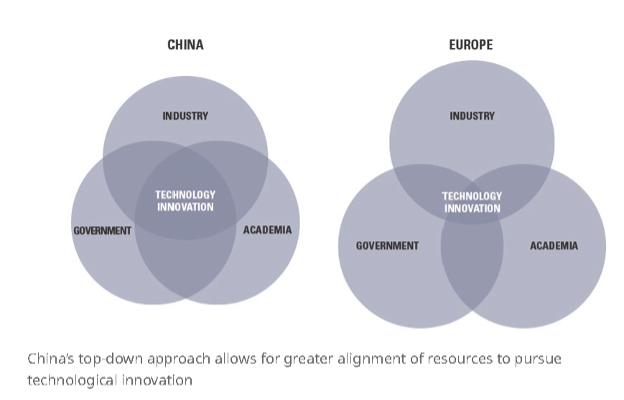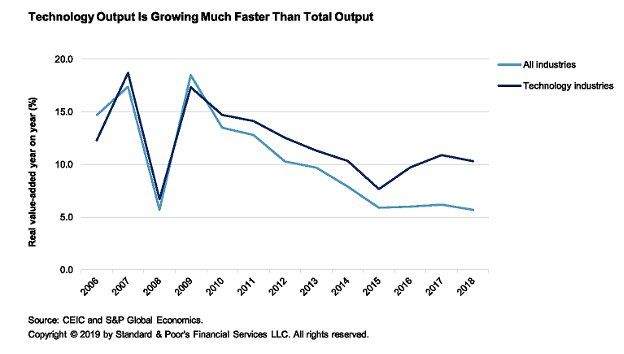
By Arthur Guarino and Wenjing Wang
China is making a rapid and aggressive metamorphosis into becoming a global leader in innovation in scientific and technologically advanced products and services. This has resulted in unicorn technology companies such as the media powerhouse Tencent, DJI, a global leader in producing drones, and China’s version of Uber, Didi Chuxing.
China is working diligently to becoming an innovator in new scientific and technological advances in ecommerce, search engines, and entertainment. This effort will involve vast sums of money, time, effort, and energy in research and development that is reaching levels of 20 percent annually. China no longer wants to be a follower nor a copier but a leader, in fact the sole leader, in innovative scientific and technological discoveries.
China is moving away from being a nation that can make a product cheaper than another country and become the inventor of new and innovative goods and services. This is an aggressive move by a nation that as recent as the 1980’s was trying to move on to the world stage as an economic player. China is trying very hard to become a global technology leader and the largest digital economy in a relatively short time. The Chinese government believes that the faster the pace of cyberspace construction, the more the possibility that China’s economy would “overtake the corner” from other countries in the new millennium. While there may be peaks and valleys that China will encounter along the way, its leadership is solidly determined to reach that goal.
What is China doing?
China is making a fast move to becoming a global technology and science leader. It uses the United States as its example since it is the home of companies such as Apple, Microsoft, IBM, Tesla, and Alphabet, to name a few. By making its push into technology and scientific innovation, China has become the founding home to four of the globe’s ten largest internet and technology companies which are Alibaba, Baidu, Tencent, and Xiaomi. Also, investors are recognizing China’s aggressive moves by putting large sums of financial capital into these companies. This has resulted in the market capitalization for that country’s largest internet companies exceeding $400 billion.
While China is making an aggressive move into becoming the world’s technology leader in order to sell more of its products abroad it is focusing on high-tech. This has resulted in an amazing growth of exports of high-tech products that grew 33 percent on an annual basis from 1995 to 2008, resulting in a dramatic leap of products going to overseas markets from $10 billion to $416 billion in the same time period.
China is also attempting to substantially increase its internet usage rate from 60 percent versus 89 percent in the United States. But in terms of sheer numbers, there are three times as many internet users in China than there are in the United States resulting in over 800 million Chinese having internet access. This is important for China since this means there is increasing access to mobile devices from companies such as Huawei, Oppo, and Vivo. If these companies can capture the Chinese market, with as many users as it has, then the next step is to go to foreign markets and make inroads there. But seeking access to information is not the only reason for using mobile devices. More than 583 million Chinese use their mobile devices and phones to pay for products and services which is more than the total population of the United States. This is important to Chinese technology companies because if they can service and satisfy this number of Chinese customers, a market such as the United States will not be a problem.
In order to make headway into the global markets, Chinese leaders and high-tech companies are being aggressive in remaking the country into an innovation powerhouse. This can be seen through China’s rise in the Global Innovation Index. In 2015, China ranked 29th in the world according to the Global Innovation Index, but rose to the 25th spot in 2016, and 22nd place in 2017. In 2021, China was ranked 12th. This is an important development since it is now being recognized that China is seeking respect and acknowledgment by the global community in terms of its aggressive move in technology and science.
As part of this move toward technology leadership, since the 1980’s China is taking a strategic move toward building human capital. This means improvement in the college level education system, especially in the areas relating to science, technology, engineering, and mathematics or most commonly known as STEM. China has seen the enrollment rate for students in the area of higher education and vocational education go from 3 percent in 1980 to 24 percent in 2010. This is important to China because if it wishes to advance and become a technology and science leader, there is a serious need for researchers, engineers, scientists, and technology managers and this must start in the country’s educational system. These are only a few of the moves China is making to become a technology and science innovation leader. Yet, the key question is: Why make such moves?
Why is China making a push to innovation?
There are key reasons why China is making a strong push into scientific and technological innovation.
First and foremost, China is seeking a path toward technological independence that is rooted in the concept of self-determination. China started with a national policy of manufacturing products and goods for export to the United States, Europe, and anywhere else it could send these items. As far as its place in the value chain, while manufacturing was not necessarily at the bottom, it was a starting point for China in order to build and grow its macroeconomy. Manufacturing gave its people jobs and a chance to earn a living. But there was still the need to expand its economy and become a leader rather than dependent on whether other markets will continue to buy its products and goods. This would mean advancing its research base in order to produce advanced technology that could compete with the likes of the United States, Japan, and Germany. While this move would not be easy, China has made it a national policy to become self-sufficient in a rather short period of time.
As Premier Li Kegiang has stated in his report to the National People’s Congress (NPC) in 2021:
We will give priority to domestic circulation, and work to build a strong domestic market and turn China into a trader of quality. We will leverage the flows of the domestic economy to make China a major magnet for global production factors and resources, thereby promoting positive interplay between domestic circulation and international circulation.
This tactic is known as the “dual circulation” strategy that is intended to protect China from the risks of substantial exposure to the ups and downs on the international marketplace. China is using this strategy to protect itself from the present and past economic and financial conflict it has had with the United States, especially the trade war that was started in the Trump Administration. China’s policymakers are unsure which path the Biden Administration will take, so in the meantime the strategy is to place more emphasis on growing its domestic market, become a technological and scientific juggernaut, and diversify its economy in order to propel economic growth in the coming decades.
Another reason why China is making a concerted push to innovation is that it has a great deal of catching-up to do. For too long, China has fallen behind other nations in terms of economic growth and financial expansion. Under President Xi Jinping, China is making a super aggressive move to not only join countries such as the United States, Japan, and Germany in terms of scientific and technological advancement, but eventually surpass them. Under Xi, China is aggressively making advances in areas such as robotics, cloud computing, automation, and artificial intelligence (AI). Xi realizes that China must run faster than it ever has regarding its push for scientific and technological expansion. In the fourteenth Five-year plan (2021-2025), China has defined its five factors of production as data, land, labor, capital, and technology, which are different from the traditional western economy which are land, labor, capital, and entrepreneurship. Xi has called this as “great changes not seen in 100 years” in order to move China into a new era in innovation.
This will not be an easy move since it will require substantial investment in research and development (R&D). But China is making the investment no matter what the cost. The Ministry of Science and Technology, has stated that China’s expenditures on R&D was 2173.7 billion RMB (approximately U.S. $3,080 billion) in 2019, in which over 78 percent were made by commercial enterprises. China is also making further investments in R&D in which the gross domestic expenditure on R&D (GERD) was 2.19 percent of GDP in 2019, a 10.5 percent increase from the year 2018 and representing a 29-year continuous growth rate.
A third reason why China is making its push for innovation is that even if it does not achieve its long-term objective of scientific and technological leadership, such a strategy will ultimately help strengthen and improve vital sectors such as manufacturing, finance, education, and healthcare. China does not want to continue to rely on foreign technology and scientific innovation when it has financial, human, and economic resources that can be used to create new technology and make its own scientific discoveries. This means having an educated workforce that can create new technologies and work for Chinese companies that can compete aggressively in both domestic and international markets. China knows it must focus not only on an extensive quantity of innovation but also quality that will result in extensive leadership in areas such as smart manufacturing, and AI in which the technology is extremely difficult to copy through such mechanisms as reverse engineering.
How is China making the push to innovation?
There are numerous ways in which China is making its aggressive push for scientific and technological innovation:
Emphasis on basic research: China’s central and provincial government policymakers are working on a strong focus on basic research at the university, institutes, and on the corporate level. Basic research, or fundamental research, is generally defined as a “type of investigation focused on improving the understanding of a particular phenomenon, study or law of nature. This type of research examines data to find the unknown and fulfill a sense of curiosity. Usually, these involve how, what and why questions to explain occurrences. Basic research looks at how processes or concepts work. Information obtained from basic research often creates a foundation for applied studies.” Basic research can later be used for other aspects of finding the solutions to various scientific, engineering, medical, or biological problems or questions. But basic research is a long-term commitment that China is willing to make through sufficient financial capital funding, thousands of trained PhDs who are scientists, technicians, and engineers, and the patience for seeking answers to difficult problems.
Building nation-wide R&D networks: China’s commitment to technological development is being led by the central and provincial governments through initiatives such as the Five-Year Plans or Made in China 2025. But this means building a massive resource network that will involve the entire nation in which all national human talent and firms will be utilized even those from inland cities and territories. This is important since China needs to use all the human resources it has and make firms and individuals living inland feel that they are part of the changes occurring in the country. In this case firms can work with research-based universities and institutes to generate new ideas, find solutions to complex problems, and make a common use of the resources that they each possess. Sharing of resources, knowledge, and discoveries through nation-wide R&D networks will reduce the duplicating of efforts by firms and research universities and institutes. Expanding R&D networks to inland cities and territories will eventually help to spread financial resources to places that would not normally be able to obtain or have access to them in prior times. This is necessary for a long-term plan to make an aggressive push to achieve leadership in scientific and technological innovation.
Development of Commercialization Programs: China is making discoveries by government research universities and institutes available to Chinese companies for commercial use. A key example of this is the Torch Program which came into being in 1986 through the auspices of the State Science and Technology Commission (SSTC). The aim of the SSTC is to take discoveries made by research universities and institutes and make them available to new technology enterprises (NTEs) so that these entities can bring these new found ideas to market and commercial use. The Torch Program is actually a technology incubator in which financial capital funding comes from banks or state-owned enterprises, and helps to make managers out of scientists, engineers, and technicians. The aim is to take new discoveries made by scientists and technologists and bring them into commercial application at a faster rate than before. But the key is to create a synergy between research and commercial use through the creation by the SSTC of 52 high-technology zones which are the equivalent of research parks found in the United States that are rooted by NTEs. This has resulted in successful NTEssuch as Legend Computer which manufactures PCs, Stone Company that produces a popular word processing program, and Founder Company that makes a typesetting software used globally. These commercialization programs will more than likely produce other NTEs that will make a global impact in science and technology.
Will China succeed?
The key question that economists, policymakers in other parts of the world, and business leaders ask themselves is: Will China succeed? The answer to this question not only affects the Chinese people, but its economy, its financial future, and its standing in the global community of nations. But the answer will also affect the industrialized and technologically advanced nations such as the United States, Japan, and Germany, to name a few. They realize that China is not only aggressive in its push to be an innovation leader in science and technology, but that it is analogous to a giant that is awakening to its potential in the world stage.
The move by China will not be an easy one and will have its share of ups and downs. China must also realize that not only will the industrialized and technologically advanced nations have a huge start but will do what they can to maintain their lead. China has a great deal of ground to make up in its attempt to become a global leader in science and technology. Also, there are other nations that are going to make every attempt they can to catch up to China’s move to becoming a global leader in science and technology. These other nations may be smaller in size, but perhaps collectively they can make headway and give China a run for its money.
The future holds many unknowns and numerous questions, but only time will tell what will ultimately occur.
Arthur Guarino is a finance professor at Rutgers University in New Jersey. Professor Guarino’s professional career has been deeply involved in the financial services industry with such corporations as TIAA-CREF, Met Life, and The Bank of New York Mellon. He has held various positions in the financial services field including sales, training and development, administration, product development, customer service and relationship, and management.
Wenjing Wang is a Finance lecturer in Accounting and Financial Management department at Zhejiang Business College, China. She is also the vice-president at Zhong Xiang venture capital company with responsibilities of writing due diligence and managing customer relations. She is also an investor who has invested in different projects and gained great insights into the business field.







